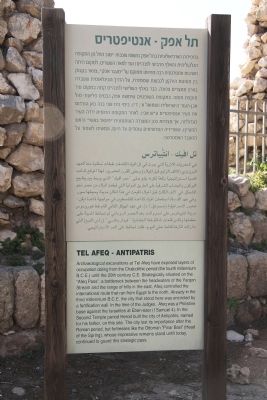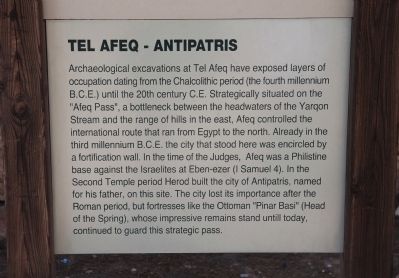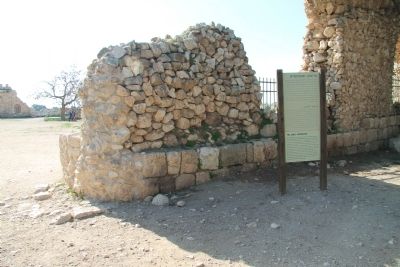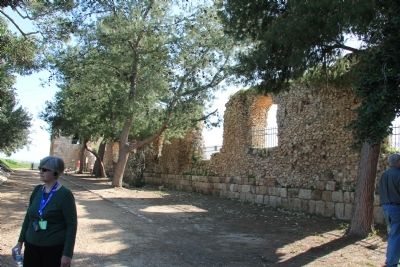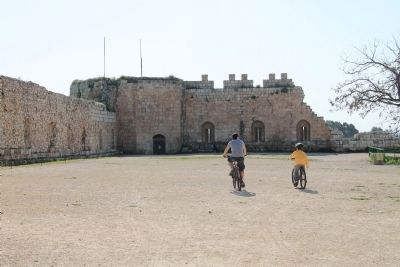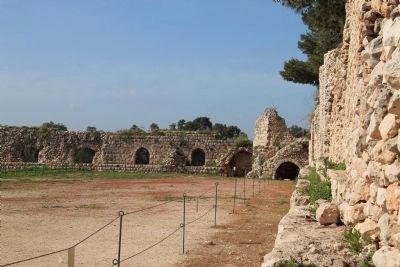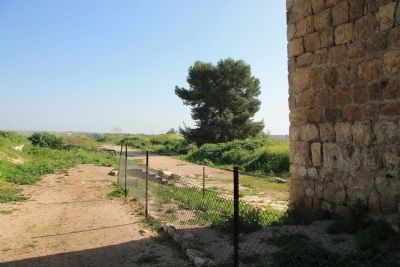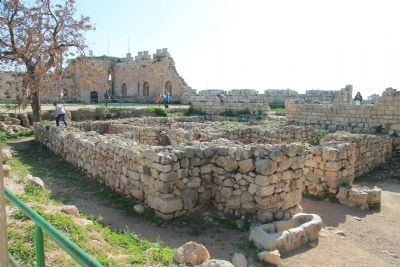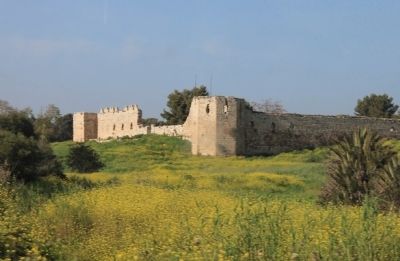Near Rosh Ha'ayin, Central District, Israel — West Asia (the Levant in the Middle East)
Tel Afeq - Antipatris
Archaeological excavations at Tel Afeq have exposed layers of occupation dating from the Chalcolithic period (the fourth millennium B.C.E.) until the 20th century C.E. Strategically situated on the "Afeq Pass", a bottleneck between the headwaters of the Yarqon Stream and the range of hills in the east, Afeq controlled the international route that ran from Egypt to the north. Already in the third millennium B.C.E. the city that stood here was encircled by a fortification wall. In the time of the Judges, Afeq was a Philistine base against the Israelites at Eben-ezer (1 Samuel 4). In the Second Temple period Herod built the city of Antipatris, named for his father, on this site. The city lost its importance after the Roman period, but fortresses like the Ottoman "Pinar Basi" (Head of the Spring), whose impressive remains stand until today, continue to guard this strategic pass.
Topics. This historical marker is listed in these topic lists: Anthropology & Archaeology • Forts and Castles • Settlements & Settlers.
Location. 32° 6.317′ N, 34° 55.826′ E. Marker is near Rosh Ha'ayin, Central District. Marker can be reached from Yarkon Park Entrance Roadway just north of National Route 483. This historical marker is located in the interior of Yarkon Park, along a walking path that leads to the entrance of the Ottoman Fortress, just to the right (north) of the southeastern corner entrance to the fortress. Touch for map. Marker is in this post office area: Rosh Ha'ayin, Central District 48800, Israel. Touch for directions.
Other nearby markers. At least 7 other markers are within 19 kilometers of this marker, measured as the crow flies. The Roman Cardo (within shouting distance of this marker); The Egyptian Governor's Residence (within shouting distance of this marker); The Lion Temple (approx. 17.7 kilometers away in Tel Aviv District); The Jaffa Port (approx. 17.8 kilometers away in Tel Aviv District); The Whale Sculpture (approx. 17.8 kilometers away in Tel Aviv District); The First Jewish Hostel in Jaffa (approx. 17.9 kilometers away in Tel Aviv District); The House of Simon the Tanner (approx. 17.9 kilometers away in Tel Aviv District).
Regarding Tel Afeq - Antipatris. In the December of 2000 edition of the Jewish Magazine (see 2nd related link) they make the following observation, "The park now forms a more fitting background for the antiquities in Tel Afek, although the finds are a bit difficult to find as there are no indicating signs. This is a pity because now it would be easy to miss that Tel Afek is one of the most important biblical places in Israel."
I confess that when I visited this site, with my tour group, in March
of 2013, I was disappointed that there weren't more historical markers to help explain the importance of the site and to mark where the archaeological evidence of this important site could be found. I only managed to find three markers, but because I was with a tour group I had a limited amount of time to search for additional markers.
The ruins of the Ottoman fortress are by far the most visually significant and impressive archaeological evidence at this site. But I didn't come to this location to see Ottoman era ruins, I came because the Book of Acts detailed the Apostle Paul's brief visit to this site on his way to the Caesarea Maritima (see Acts 23: 31). I was looking for Roman ruins that dated back to the time of Paul's visit.
I was initially disappointed in my quest to see and experience the Roman ruins from the time of Paul, but once I could bring myself to look beyond the Ottoman fortress I was able to see two other important groups of ruins. The first were the Roman ruins which are located along the Roman road that runs southeast from the southeastern fortress tower. These Roman ruins aren't nearly as numerous or significant as I had seen in visits to places like Beth Shean or Sepphoris, but I was still pleased to be walking on the very same Roman road that Paul had traveled upon.
Unfortunately, I was unable to see much more of the Roman ruins
than what was in the immediate vicinity of the southeast tower of the fortress. Had I more time, I would have liked to have walked to the end of what had been excavated of the Roman road, within the park (see the aerial photograph view of the park that is in the 5th related link).
The second important group of ancient ruins that can be seen at this site are the excavations of the Egyptian Governor's residence, which date back to the Late Bronze Age (1,550-1,200 BC). I confess that this was just another example for me of a very strong Egyptian presence in the Biblical land of Canaan, during this period of history, that prior to my trip to Israel, I was pretty much unaware of. So I found these ruins to be very significant and insightful to my understanding of the history of this region.
Related markers. Click here for a list of markers that are related to this marker. To better understand the relationship, study each marker in the order shown.
Also see . . .
1. Yarkon Park. This is a link to information provided by Wikipedia, the free encyclopedia. (Submitted on April 11, 2013, by Dale K. Benington of Toledo, Ohio.)
2. Archaeology in Israel: Tel Afek. This is a link to related information provided by the Jewish Magazine. (Submitted on April 11, 2013, by Dale K. Benington of Toledo, Ohio.)
3. Antipatris.
This is a link to information provided by Wikipedia, the free encyclopedia. (Submitted on April 11, 2013, by Dale K. Benington of Toledo, Ohio.)
4. Afek in the Sharon (Antipatris). This is a link to information provided by BibleWalks.com (Submitted on April 11, 2013, by Dale K. Benington of Toledo, Ohio.)
Credits. This page was last revised on June 5, 2023. It was originally submitted on April 11, 2013, by Dale K. Benington of Toledo, Ohio. This page has been viewed 725 times since then and 16 times this year. Photos: 1, 2, 3, 4, 5, 6, 7, 8, 9. submitted on April 12, 2013, by Dale K. Benington of Toledo, Ohio.
